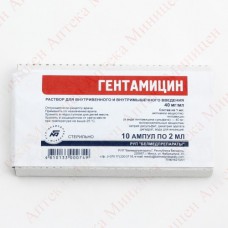Expiration date: 03/2026
Dosage form: solution for intravenous and intramuscular administration
Composition: Active ingredient: Gentamicin Sulphate (equivalent to Gentamicin base) - 40, the Subsidiary substances: sodium metabisulfite, disodium EDTA (Trilon B), water for injection up to 1 liter.
Description: Clear, colorless or slightly colored liquid.
Pharmacotherapeutic group: antibiotic, an aminoglycoside.
Pharmacological properties
Bactericidal broad-spectrum antibiotic of the aminoglycoside. Associated with the 30S subunit of the ribosome and disrupts protein synthesis by inhibiting the formation and transport of the messenger RNA of the complex, while there is an erroneous reading of the RNA and the formation of non-functional proteins. It has bactericidal action - in high concentrations reduces the barrier function of the cytoplasmic membrane and causes the death of microorganisms.
Highly sensitive to gentamicin (MIC less than 4 mg / l) Gram-negative organisms - Proteus spp. (Including indolpolozhitelnye indolotritsatelnye and strains), Escherichia coli, Klebsiella spp, Salmonella spp, Shigella spp, Campylobacter spp, Gram-positive bacteria -.... Staphylococcus spp. (Including penicillin), responsive at IPC 4.8 mg / l - Serratia spp, Klebsiella spp, Pseudomonas spp... (Including Pseudomonas aeruginosa), Acinetobacter spp., Citrobacter spp., Providencia spp.
Resistant (MIC of more than 8 mg / l) - Neisseria meningitidis, Treponema pallidum, Streptococcus spp. (Including strains of Streptococcus pneumoniae and Group D), Bacteroides spp., Clostridium spp., Providencia rettgeri.
In combination with penicillins (including with benzylpenicillin, ampicillin, carbenicillin, oxacillin) acting on the synthesis of the cell wall of microorganisms, is active against Enterococcus faecalis, Enterococcus faecium, Enterococcus durans, Enterococcus avium, virtually all strains of Streptococcus faecalis and species (including Str.faecalis liguifaciens, Str.faecalis zymogenes), Streptococcus faecium, Streptococcus durans.
Microbial resistance to gentamicin develops slowly, but strains resistant to neomycin and kanamycin, can also exhibit resistance to gentamicin (incomplete cross-resistance). Do not act on fungi, viruses, protozoa.
Pharmacokinetics: After intramuscular (i / m) administration is absorbed rapidly and completely. The time to maximum concentration (TSmax) after the / m - 0.5-1.5 h after 30 min intravenous (i / v) infusion - 30 min, 60 min after i / v infusion - 15 min, Cmax value after in / m or / in the 1.5 mg / kg is 6 mg / ml.
Communication with plasma proteins - low (10%). The volume of distribution in adults - 0.26 L / kg in children - 0.2-0.4 l / kg, neonatal aged 1 week and weighing less than 1.5 kg - up to 0.68 l / kg aged 1 week and body weight over 1.5 kg - to 0.58 l / kg.
Found in therapeutic concentrations in the liver, kidney, lung, pleural, pericardial, synovial, peritoneal, ascites and lymph fluid, urine, discharge of wounds, pus, granulation. Low concentrations are found in adipose tissue, muscles, bones, bile, breast milk, the aqueous humor of the eye, bronchial secretions, sputum, and cerebrospinal fluid (CSF). In adult therapeutic concentrations practically does not penetrate the blood-brain barrier (BBB), meningitis concentration in CSF increases. In newborns reached higher concentrations in the CSF than in adults. It penetrates through the placenta.
Do not metabolized. The half-life (T 1/2) for adults - 2-4 hours, in children between the ages of 1 week to 6 months - 3-3.5 hours, in newborns and premature babies weighing more than 2 kg - 5.5 hours , weighing less than 1.5 kg - 11.5 hours to 2 kg - 8 hours.
Write mainly kidneys in an unmodified form, in small quantities - with bile. In patients with normal renal function displayed 70-95% during the first day, with urine concentrations are more than 100 mcg / ml. In patients with reduced glomerular filtration excretion is significantly reduced.
Displayed in hemodialysis - every 4-6 hours the concentration is reduced by 50%. Peritoneal dialysis is less effective - for 48-72 hours to return 25% of the dose. For repeated administrations accumulates primarily in lymphatic inner ear space, and in the proximal renal tubules.
Testimony
Bacterial infections caused by sensitive microflora: infections of the upper and lower respiratory tract infection (including bronchitis, pneumonia, empyema), complicated urogenital infections (including pyelonephritis, cystitis, urethritis, prosttit, gonorrhea, endometritis), infections bones and joints (including osteomyelitis), skin and soft tissue infections, abdominal infections (peritonitis, pelvioperitonit), CNS infections (meningitis, etc.), sepsis, wound infection, burn infection, otitis media.
Contraindications
Hypersensitivity (including to other. Aminoglycosides in history), neuritis of the auditory nerve, severe chronic renal failure (CRF) with azotemia and uremia, pregnancy.


